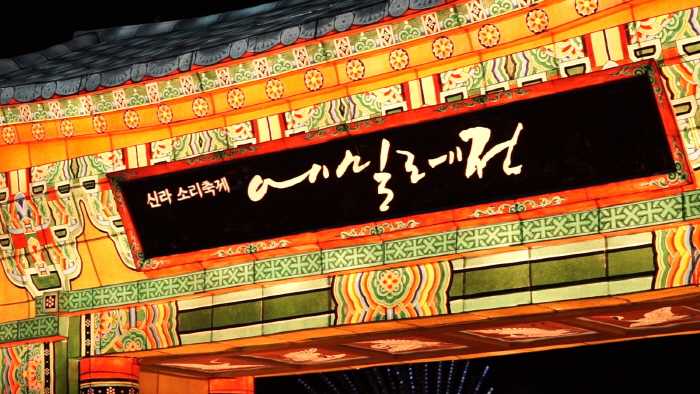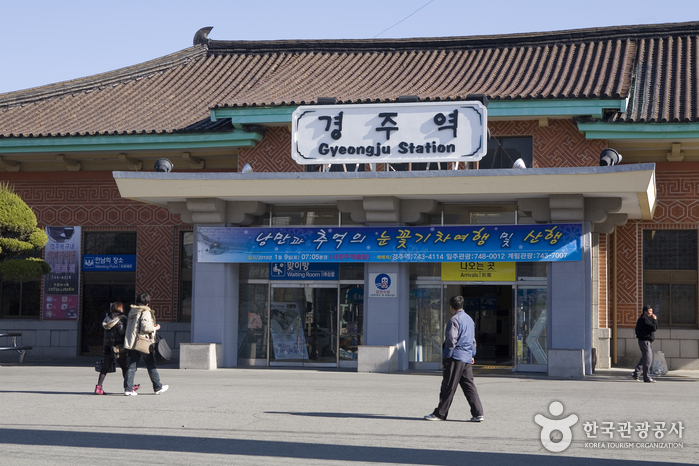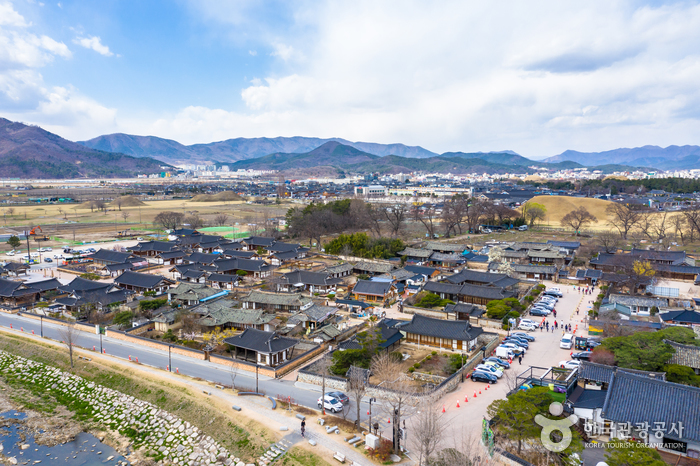Wiyeonjae Hanok Stay [Korea Quality] / 위연재 [한국관광 품질인증/Korea Quality]
6.4 Km 4 2021-03-29
7, Jjoksaem-gil, Gyeongju-si, Gyeongsangbuk-do
This hanok (traditional Korean house) is located very near to Cheomseongdae Observatory. Its location in front of the Gyeongju Historic Areas allows guests to reach major sights in Gyeongju like Daereungwon Ancient Tomb Complex, Donggung Palace and Wolji Pond, and Hwangnidan-gil Street by foot. This hanok symbolizes the historicity of the city of Gyeongju in that during its construction a female skeleton and accessories made out of precious metals were excavated from the site. The accommodation’s name comes from the idiom “Muwijayeon (leaving nature as it is),” combining bamboo and pine trees with green grass, show its dedication to ideals of rest and philosophy.
There are five rooms in total, all ondol (under-the-floor heating system) rooms for two. Korean paper lining the walls and old-fashioned furniture speak to the ideal beauty of hanok. The raised floor space, which is attached to the “Munmu” room, is a great place to enjoy the scenery and take pictures. All rooms have modern bathrooms with shower facilities, and a complimentary breakfast is served in the cafe on site from 8:00 to 9:00 in the morning. The complex has abundant parking spaces for the guests.
Festival Silla Sori, Emille (신라소리축제 에밀레전)
6.4 Km 3080 2019-11-11
Gyeongsangbuk-do, Gyeongju-si, Chamseong-ro 147
1899-1098
Le festival Silla Sori traite de l’histoire de la cloche divine du roi Seongdeok, inauguré durant la période Silla en Corée. Le festival a lieu à Gyeongju et traite donc d’un patrimoine culturel vieux de plus de 1000 ans. Le festival est organisé par la chaîne BBS (chaîne bouddhiste en Corée), et est sponsorisé par la ville de Gyeongju, la région Gyeongsangbuk-do, par le temple Bulguksa et par le ministère de la culture et des sports en Corée. Le festival occupe un vaste champ d’herbe autour de l’observatoire Cheomseogdae. Vous pourrez ainsi apprécier la culture Silla de plus près durant la période du festival.
Pont Woljeonggyo (월정교)
6.4 Km 16 2023-01-18
274, Gyo-dong, Gyeongju-si, Gyeongsangbuk-do
Ce pont a été construit à Gyo-dong dans la ville de Gyeongju-si (région Gyeongsangbuk-do) pendant la période du royaume unifié de Silla. Il a été endommagé sous la dynastie Joseon avant d'être restauré en avril 2018 en tant que plus grand pont en bois de Corée.
Selon le livre Samguksagi, il fut bâti durant la 19e année du règne du roi Gyeongdeokwang (760) du royaume unifié de Silla afin de relier Wolseong et Namsan à Gyeongju.
Yosokkoong (요석궁)
6.4 Km 53073 2020-07-14
19-4, Gyochonan-gil, Gyeongju-si, Gyeongsangbuk-do
+82-54-772-3347
Named after Silla King Muyeol's daughter, Princess Yoseok, Yosokkoong serves traditional Korean food. The resturant is run by the Choi family, who settled on the site of Princess Yoseok's house during the Joseon dynasty, and has passed on the restaurant and family recipes through 12 generations. All the foods served are made with organic ingredients, for a healthy taste that cannot be found anywhere else.
Gare de Gyeongju (경주역)
6.5 Km 11818 2021-03-17
266, Wonhwa-ro, Gyeongju-si, Gyeongsangbuk-do(Seongdong-dong)
Situé dans le quartier de Seongdong-dong à Gyeongju-si, (province du Gyeongsangbuk-do), la gare de Gyeongju a ouvert ses portes le 1er novembre 1918. La gare, partie intégrante de la ligne Donghae Nambu, est le dernier arrêt de la ligne Jungang.
Nadul Hanok [Korea Quality] / 나들한옥 [한국관광 품질인증]
6.6 Km 261 2020-09-09
4-1, Jjoksaem-gil, Gyeongju-si, Gyeongsangbuk-do
+82-54-777-7738
Nadeul Hanok was opened in 2018 with brand-new facilities, in a location just a minute’s walk from Cheomseongdae Observatory in Gyeongju. You can feel a sense of healing in nature in the traditional style house, built in environment-friendly construction method with wood and earth. The ‘ㄷ’-shaped building creates a snug atmosphere and the hipped-and-gable roof and the curves of the roof tile show the traditional quiet and still flavor of a traditional Korean house. There are 7 rooms in Nadeul Hanok. Among them, the Garam, Gayeon, and Nuri Rooms are offered at 50,000 won for 2 persons during off-season so that visitors can enjoy staying in a traditional Korean house at more affordable prices. All rooms are equipped with a bathroom for better convenience and there is an individual thermostat all year round. Complimentary breakfast made of healthy convenience food is offered to all guests. The menu is composed of barley bread, fruit, coffee, juice, boiled egg, and biscuit, and is subject to change according to situation. What is good is that the breakfast can be delivered to the room if the delivery time is requested during breakfast time, which is from 8 to 9 AM.
It is possible to look around the tourist attractions near Nadeul Hanok on foot. In addition, there are CVs, fast food shops, bike rental shops, and hanbok rental shops adjacent to Nadeul Hanok, enabling a more convenient and joyful tour.
Voyage nocturne à Gyeongju 경주야행 (외국어사이트용)
6.6 Km 0 2017-04-18
Gyeongsangbuk-do, Gyeongju-si, Gyochon-gil 31-11
141MINIHOTEL [Korea Quality] / 141미니호텔 [한국관광 품질인증]
6.6 Km 4106 2020-09-10
141, Wonhyo-ro, Gyeongju-si, Gyeongsangbuk-do
+82-10-9031-1628
'Located in Gyeongju, the capital of Silla Kingdom for 992 years, 141 Mini Hotel lets you enjoy hotel services at motel room rates. It has sauna, book café, small conference room, and business center for the convenience of its guests. The hotel staff are friendly as well. It's very conveniently located, since it's only 5 minutes away from Gyeongju Station and 10 minutes away from the Bus Terminal, both on foot. There are many popular tourist destinations in the vicinity of the hotel, including Donggung Palace, Wolji Pond, Cheomseongdae Observatory, and Bulguksa Temple.
Village Gyochon de Gyeongju (경주 교촌마을)
6.6 Km 27543 2020-10-06
39-2, Gyochon-gil, Gyeongju-si, Gyeongsangbuk-do
+82-54-760-7880
Le village Gyochon de Gyeongju est un village traditionnel constitué de hanok devenu site touristique proposant diverses activités pratiques pour les visiteurs. Le village abrite notamment la maison Gyeongju Choi Ssi, classée comme 27ème trésor du patrimoine folklorique en Corée ainsi qu'une fabrique de l'alcool Gyeongju Gyodong Beopju classé trésor immatériel num. 86-3.
Grotte de Seokguram [Patrimoine Mondial de l’UNESCO] (경주 석굴암)
6.7 Km 18824 2023-08-24
873-243, Bulguk-ro, Gyeongju-si, Gyeongsangbuk-do
+82-54-746-9933
Située sur les pentes du Mt. Tohamsan, la Grotte Seokguram, est considérée comme un temple en pierres typique de Corée.
Le nom officiel de la Grotte de Seokguram, Trésor National Nº 24, est 'Seokguram Seokgul'. Désignée comme patrimoine culturel mondial de l’UNESCO en 1995, il s'agit ici d'une grotte artificielle composée de granites.
Sa construction a d’abord commencé par l'intermédiaire de Kim Dae-Seong (700~774) en 751 durant le règne du Roi Gyeongdeok (742~765) de la Dynastie Silla (57 B.C.~A.D. 935), elle a été achevée en 774 durant le règne du Roi Hyegong (765~780).
La Grotte de Seokguram est connue pour avoir été construite avec le temple Bulguksa, ces deux-ci forment un ensemble d’architecture religieuse d’une valeur exceptionnelle. D’après le livre d’histoire Samgungnyusa de la Dynastie Goryeo (le pays qui a unifié la péninsule coréenne, à la fin de la dynastie Silla, 918~1392), Kim Dae-Seong a construit le temple Bulguksa pour ses parents et la Grotte de Seokguram pour ses parents précédents dans le monde spirituel.
![Wiyeonjae Hanok Stay [Korea Quality] / 위연재 [한국관광 품질인증/Korea Quality]](http://tong.visitkorea.or.kr/cms/resource/51/2708951_image2_1.jpg)



![Nadul Hanok [Korea Quality] / 나들한옥 [한국관광 품질인증]](http://tong.visitkorea.or.kr/cms/resource/86/2636486_image2_1.jpg)
![141MINIHOTEL [Korea Quality] / 141미니호텔 [한국관광 품질인증]](http://tong.visitkorea.or.kr/cms/resource/21/2577221_image2_1.jpg)

 Français
Français
 한국어
한국어 English
English 日本語
日本語 中文(简体)
中文(简体) Deutsch
Deutsch Español
Español Русский
Русский